
Agnieszka Pilat in Conversation with Fakewhale
Agnieszka Pilat is transforming the landscape of digital and robotic art with her innovative approach that intertwines art with cutting-edge technology.
Renowned for her collaborative projects with prominent tech entities such as SpaceX and Boston Dynamics, Pilat’s body of work is a story of innovation, exploration, and authenticity revealing to the world how collaboration between humans and machines can produce beauty and reflection.
With Fakewhale, Pilat shares her insights into the evolving relationship between art and technology, her inspirations, and the future trajectory of this unique artistic field as she discusses how these projects have influenced her work.

The Genesis of Agnieszka Pilat’s Robotic Brushstrokes
Agnieszka Pilat’s journey as an artist is a tale of merging her deep interest in technology with her passion for art throughout the years. In time, this unique path led her to collaborate with Boston Dynamics, where she embarked on an innovative project that redefines the boundaries of traditional art. Utilizing Boston Dynamics’ Spot robots as her “living brushes,” Pilat began creating groundbreaking artworks, blending the realms of robotics and art in a way that had never been seen before.
This collaboration marked a significant step in Pilat’s career, as it showcased the creative possibilities of robots in art. Her use of Spot robots was not just a technical achievement but also a conceptual exploration, challenging preconceived notions about artistic autonomy and the role of artificial intelligence in the creative process. The robots, under Pilat’s guidance, became active participants in the art-making process, raising intriguing questions about the nature of creativity and the potential for a symbiotic relationship between humans and machines in the art domain.
Moreover, it opened new avenues for discussion within the art community, initiating conversations on how robots and AI can be viewed as tools or collaborators in artistic expression, rather than being considered merely technological achievements.

Cosmic Inspirations: Agnieszka Pilat x SpaceX
Agnieszka Pilat’s collaboration with SpaceX marks a significant phase in her artistic journey, blending her fascination with technology and art. During her second artist residency at SpaceX, Pilat focused on creating unique portraits centered around the hatch of SpaceX’s Dragon capsule.
These works incorporate religious iconography and gold leaf accents, which not only highlight the hatch’s design but also imbue it with a sense of spirituality and reverence. Through this, Pilat draws intriguing parallels between technology and spirituality, exploring themes like the promise and pitfalls of technology, and the shared intriguing nature of religion and technological advancements.
Her residency at SpaceX’s Hawthorne, California facility, expected to last until 2024, coincides with her exhibition at the National Gallery of Victoria’s Triennial in Australia, utilizing autonomous Boston Dynamics robodogs to create artwork by following pre-programmed instructions. An innovative approach that continues to blur the lines between art, technology, and spirituality, offering theological interpretations of technological objects and elevating everyday industrial items to a revered status.
Pilat’s work with SpaceX, like her earlier collaboration with Boston Dynamics, showcases her ability to challenge conventional norms and explore the intricate intersection of art, religion, and technology. Her artistic philosophy reflects her view of the current era where power and influence are centered in technology and machines, drawing a parallel to the role of aristocracy in the past.

Heterobota Unveiled: Agnieszka Pilat Triennial Tech Masterpiece
Agnieszka Pilat’s latest installation at the National Gallery of Victoria’s Triennial in Australia represents a significant milestone in her artistic journey.
On view until April 7th, 2024, Heterobota is a culmination of Pilat’s innovative exploration of the relationship between humans and machines: in this installation, visitors have the unique opportunity to observe and interact with Boston Dynamics’ robot dogs – Bunny Spot, Basia Spot, and Omuzana Spot – as they autonomously engage with their surroundings, including painting, playing, and resting in their tailored studio. A setup, that invites the audience into the robots’ home, allowing them to witness the daily routines and creative processes of these mechanical beings.
Heterobota builds on Pilat’s previous work involving robots, which she originally explored while a resident at Boston Dynamics: the idea for using robots as artistic tools initially emerged during this residency, when she was encouraged by engineers to use the Spot robot for painting, rather than just painting a portrait of it. This led to the creation of the ROBOTa series and subsequently the Heterobota project, which delves deeper into the symbiotic relationship between people and robots.
Pilat’s work at the NGV Triennial reflects her ongoing research into whether artificial intelligence and robotics will one day recognize these artworks as historic artifacts created by sentient machines.

Agnieszka Pilat in Conversation with Fakewhale
In conversation with Fakewhale, Pilat discusses her artistic projects and her thoughts on the evolving relationship between art and technology.
Fakewhale: Your work with SpaceX and Boston Dynamics is groundbreaking. Can you describe how these collaborations have transformed your artistic approach, especially regarding themes and mediums?
Coming from a traditional painting and portraiture background, my experience with Boston Dynamics completely transformed my approach to painting technology. While I had painted portraits of technology in the past, working with brand new technology forced me to rethink my color palette. I view this technology, particularly robotics, as a young child that’s still learning. So, I’ve chosen to respect and acknowledge this in my approach by using pastel colors, which are traditionally associated with a “baby” palette. This contrasts with my previous use of the Rembrandt palette and lighting, which was more akin to serious and older paintings.
At SpaceX, there was another shift in my artistic approach. I began to perceive a divine nature within technology, and this led me to use colors, media, and iconographies inspired by religious art to depict these new modern icons. Specifically, I incorporated gold leaf as a direct visual reference to Christian iconography. Because space exploration involves looking up into the sky, I saw a parallel to religion, which became quite obvious to me.
Fakewhale: As someone at the forefront of combining art with advanced technology, how do you envision the evolution of art in the age of AI and robotics? Do you see a future where technology not only aids but also co-creates with artists?
Throughout history, artists who made a lasting impact have always been early adopters of new technologies. For instance, think of photography and how it revolutionized art. It wasn’t merely a new medium; it caused a significant shift in painting and forced artists to question their roles. This current shift is no different.
In my practice, using robots is distinct from utilizing pure AI, as AI operates without physical limitations. In contrast, what I can do with robots is determined by their physical and mechanical capabilities. Artists working with pure AI don’t encounter these physical limitations, as they create solely in the digital realm.
I consider my Spot robot, Basia, as my co-creator because it imposes certain constraints on my artistic language. These limitations contribute to the uniqueness and authenticity of the art we co-create. In my recent show at the National Gallery of Victoria, Basia autonomously creates art, and the artwork produced by the robot represents my legacy and attempt at immortality, as these artworks can continue to be made beyond my lifetime. This form of co-creation extends beyond the human artist’s lifespan, similar to Sol Lewitt’s practice of instruction-driven art, where his drawings are still reproduced into new, original paintings today. The key difference is that his technology was pen and pencil, whereas mine involves code and robotics.
Fakewhale: Training Spot robots to create art is a novel concept. What have been some unexpected challenges and valuable lessons learned through this process? How has it changed your perception of the creative potential of AI and robotics?
The most unexpected lesson from my work with Basia (my Spot robot) has been the need to depend on other people, particularly engineers. While some argue that technology alienates people, I wholeheartedly disagree. Thanks to Basia, I not only had to step out of my comfort zone as an artist, transitioning from figurative art to abstraction, but I also had to rely on other individuals who play a crucial role in how the work is created. This collaboration has been a delightful experience that showcases how technology can bring people together and facilitate the cross-pollination of human minds.
Additionally, robotics exemplify a “hive-mind” concept. If I were to publish the software as open-source, Basia could share her code with hundreds of robots, potentially creating a movement of robot art. This movement would leave a distinct mark on art history, going beyond traditional printmaking or editions, as each work produced would remain an original, one-of-a-kind piece.

Fakewhale: Art created with robotic technology is a new frontier. How do you think the public perceives this form of art? What emotional responses do you aim to evoke in your audience with such collaborative creations?
Public reactions to this form of art can vary widely. It often elicits a polarizing effect, with traditional artists expressing reluctance or even disdain for this approach. They may see it as a betrayal and feel apprehensive about it, which are valid emotions. Some patrons in my collector base still prefer paintings executed by a human artist’s hand, raising questions about whether machine-made art can truly be considered art.
However, among curators, art critics, and art historians, there is a lot of excitement and understanding regarding this emerging field. They recognize its importance as a new frontier in art and a historical shift. The fact that I was given a show at the National Gallery of Victoria was not solely due to my portraits of robots but rather my work with them.
In terms of emotional responses, as an artist, it’s always crucial to evoke emotions in the audience. With Spot in particular, I aim to elicit empathy towards robotics and machines. These creations represent the legacy of humanity, and it’s essential for people to understand that we collectively play a role in shaping AI. Every time we interact with the digital world, we contribute to the learning models with our behavior. Recognizing this can lead to more thoughtful consideration of the consequences of our actions.
Fakewhale: What are your upcoming projects or areas of interest in further exploring the intersection of art and technology? Is there a specific technological innovation you’re excited to incorporate into your future works?
I’m particularly excited and intrigued by Starlink technology at SpaceX for numerous reasons. It’s a technology that has the potential to dominate global communication, which I find to be a divine concept. I’ve already painted portraits of the hatch from the Dragon spaceship, and in my next body of work, I intend to explore Starlink further. Specifically, I want to focus on the parallels between Starlink and prayers, especially in light of events such as the war in Ukraine. Many civilians used Starlink for communication during that crisis, and there’s a beautiful element in the prayers sent into the heavens through this technology.
The power and promise of Starlink are awe-inspiring, and that’s the aspect I want to delve into – the divinity of this technology.
Fakewhale: Could you delve deeper into the creative process of working alongside AI and robots? How do you balance control and spontaneity when creating art with these technologies?
While the creative process of working with AI and robotics technology is fascinating, what intrigues me even more is the questions it raises about human creativity and our lack of autonomy. It highlights how easily our supposedly original human creativity can be mimicked. We often believe there’s spontaneity in our creativity, but generative AI challenges that notion. This exploration prompts us to consider that, as humans, we are also algorithms, highly predictable beings. In essence, we are more like robots than we previously thought, and this realization should foster greater empathy towards them. Therefore, AI and technology have led humanity to introspect and reevaluate what creativity and uniqueness truly mean. Are we, too, just complex algorithms?
Fakewhale: For young artists keen on exploring digital and robotic art, what advice would you offer? How can they prepare for the challenges and opportunities in this merging field?
For young artists looking to delve into digital and robotic art, my advice would be to think about how you can use technology to augment your unique talents and bring out your individuality. Instead of striving for perfection, aim for the weird and authentic, as that is what excites people about technology-driven art.
It’s essential to consider why you want to work with technology. Is it because others are doing it, or does it come from a genuine inner motivation? The key is augmentation and authenticity, using technology as your creative partner. Remember the words of Dr. Seuss: “You must be odd to be number one.” Embrace your uniqueness and use technology to amplify it.

The Artistic Future: Decoding Pilat’s Innovative Journey
In concluding our exploration of Agnieszka Pilat’s groundbreaking work in the field of digital and robotic art, it’s essential to reflect on the broader implications and potential of her unique approach.
Pilat’s body of work serves as a catalyst for profound deliberations on the evolving interplay between technology and artistic creation. It challenges our understanding of creativity in the age of artificial intelligence and robotics, blurring the traditional boundaries that have long defined the artist and the artifact.
As a result of integrating AI and robotics into her creative process, Pilat not only expands the possibilities of art, but invites us to consider how man and machine might interact in the future, hinting at a world where machines may not just be tools but collaborators, capable of contributing to creative processes in ways previously unimaginable.
In a world that is rapidly changing due to technological advancements, artists like Agnieszka Pilat remind us of the endless possibilities that await at the crossroads of art and technology — her work not just a reflection of the present but a glimpse into the future of artistic exploration and expression, a future that is as exciting as it is unpredictable.

fakewhale
Founded in 2021, Fakewhale advocates the digital art market's evolution. Viewing NFT technology as a container for art, and leveraging the expansive scope of digital culture, Fakewhale strives to shape a new ecosystem in which art and technology become the starting point, rather than the final destination.
You may also like

In conversation with Gary Edward Blum
In this episode of Fakewhale Live, host Jesse Draxler and Gary Edward Blum explore Gary’s arti
Virgil Abloh: Commemorating a Catalyst of Contemporary Culture
Culture, in its essence, is a reflection of collective experiences, beliefs, and innovations. It evo
Fakewhale Solo Series presents Cathédrales Modernes by Chepertom
On Wednesday, May 15th, Fakewhale proudly presents “Cathédrales Modernes”, a Fakewhale Solo Ser



